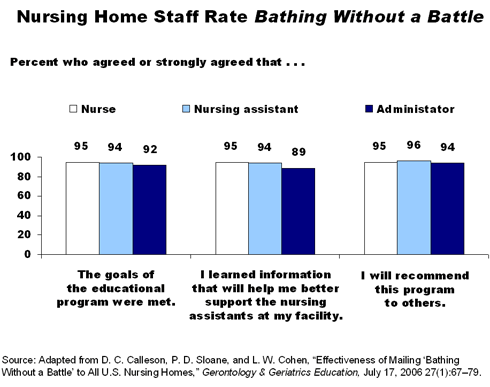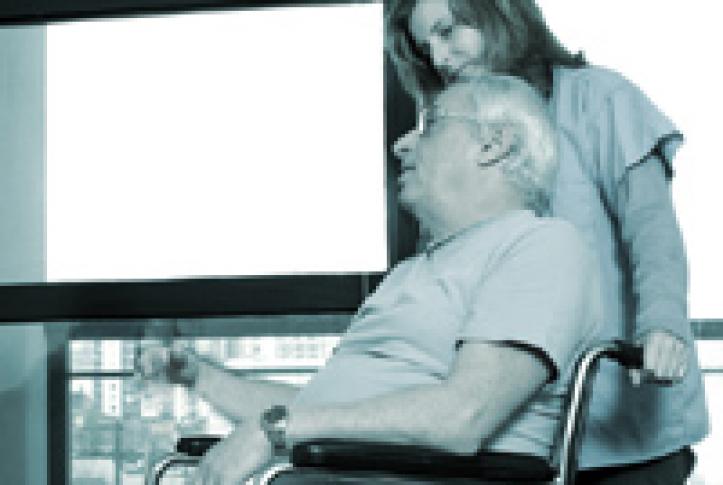In the Literature
For many nursing home residents, particularly those with Alzheimer's disease or dementia, being bathed by caregivers can be upsetting or confusing. Residents can become agitated, even aggressive—sometimes to the point of verbally or physically abusing their caregiver. Research has found that such agitation can be alleviated by tailoring bathing techniques to meet residents' needs. Yet, translating this resident-centered approach into widespread nursing home practice presents challenges.
In "Effectiveness of Mailing 'Bathing Without a Battle' to All U.S. Nursing Homes" (Gerontology & Geriatrics Education, July 17, 2006), University of North Carolina researchers Diane C. Calleson, Ph.D., Philip D. Sloane, M.D., M.P.H., and Lauren M. Cohen, M.A., evaluate the impact of a major national effort to educate nursing home staff about strategies for improving bathing routines in long-term care.
Development of "Bathing Without a Battle"
Between 1992 and 2002, researchers conducted a series of studies on two bathing techniques: "person-centered showering," which uses methods tailored to the needs and comfort level of the person being bathed; and the towel bath, which allows a resident to be bathed in bed using a towel and no-rinse soap solution. As reported in a 2004 article in the Journal of the American Geriatrics Society, they found that both techniques reduced residents' agitation, aggression, and discomfort. Aggressive incidents declined by 53 percent among residents receiving person-centered showers and by 60 percent among those receiving towel baths.
Spreading the Word
To promote the program, called "Bathing Without a Battle," the researchers developed an interactive CD that illustrates practical bathing techniques and encourages nursing home staff to develop their own customized solutions. Educational topics include showering, tub bathing, in-room bathing, hair washing, equipment and supplies, and promotion of person-centered bathing at the facility level. Free continuing education units (CEUs) were provided to nurses, administrators, and nursing assistants who completed the programs.
After a survey revealed that many nursing home staff do not have access to computers, a training video was developed to supplement the CD. In 2004, the CD and video package was mailed to over 15,000 nursing homes, as well as more than 2,000 assisted-living facilities, state ombudsmen, home care providers, and policymakers. They also launched a Web site: www.bathingwithoutabattle.unc.edu.
Evaluating Success
To gauge the effectiveness of the dissemination effort, the researchers surveyed nursing home staff in three randomly selected states (Colorado, Illinois, and Oregon). Forty-five percent of nursing home administrators surveyed were aware of having received the "Bathing Without a Battle" package. Ten percent of nursing home administrators and 23 percent of nurses or nursing assistants used the CD for educational purposes while 55 percent of administrators and 54 percent of nurses or nursing assistants used the video.
The researchers also tracked the number of nursing home staff that completed the CEUs. As of February 2005, 639 nurses, 215 nursing assistants, and 143 administrators had completed the training modules in exchange for CEUs, and 2,552 nursing assistants had received credit for viewing the educational video. Final examination scores were quite high; mean test scores exceeded 93 percent for all three types of participants.
In the evaluation, 95 percent of nurses, 94 percent of nursing assistants, and 92 percent of administrators agreed or strongly agreed that the goals of the program—increasing residents' comfort, decreasing pain, helping residents feel in control, doing in-room bathing, and washing hair without distress—had been achieved. The majority rated the educational materials as good or excellent; none rated them as poor. The "Bathing Without a Battle" Web site currently receives an average of 1,402 visits per month.
Discussion
The authors note that nursing homes tend to have relatively few professional staff members, high levels of turnover, and modest training resources—making the basic goal of implementing new clinical practices difficult. In spite of extensive efforts to disseminate "Bathing Without a Battle," more than half of the administrators surveyed said that they had not received it or did not know if they had received it.
Still, the authors regard the dissemination effort as positive, at least in the short term. Nursing home administrators and staff who used the materials found them to be useful and effective. Participants performed exceptionally well on the continuing education tests, indicating that the main concepts had been successfully conveyed.
"Bathing Without a Battle" is currently undergoing further evaluation by the New York State Department of Health, under a grant from the Agency for Healthcare Research and Quality. The four-year study is testing ways to effectively implement and sustain change in nursing homes, with results expected in 2007.




